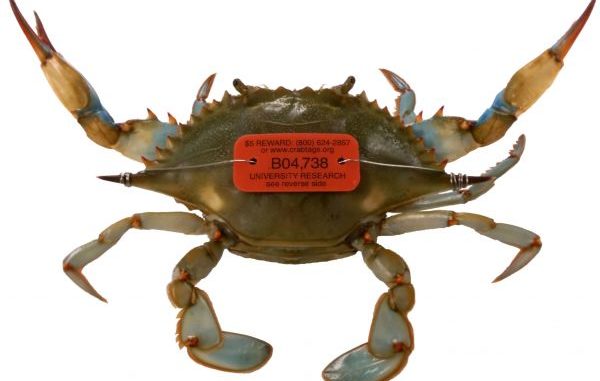
30,000 female blue crabs to be tagged in the next two years, Darnell says
Researchers at Nicholls State University hope to tag 30,000 female blue crabs Gulf-wide in the next two years to gain insight into their spawning habits and preferred migration routes.
Zack Darnell, an assistant professor in Biological Sciences who is heading up the study, said the bulk of the crabs — 12- to 15,000 — will be tagged in Louisiana waters, but the project spans from the Texas/Mexico border all the way to Apalachicola, Fla.
“We’re focused heavily on Louisiana because that’s where we are, and Louisiana is by far the largest crab-producing state in the Gulf,” he said. “We’re interested in the where, when and how of female blue crab migration.”
Typically, Darnell said female blue crabs reach sexual maturity somewhere between nine and 18 months of age. After mating, they head offshore in search of saltier water that provides ideal conditions for their offspring.
“Once they reach maturity, females mate right after they molt for the last time, and they only mate that one time,” he said. “From that one mating, they actually store the sperm and can use it to produce multiple egg masses.”
Three weeks to a month after that initial mating, they produce their first egg mass, which hatches after about 10 days.
“As soon as a week after those eggs hatch, they can produce another egg mass, and they basically keep doing that multiple times — all from that single time they mated,” Darnell said. “The females head to deeper water, and if they don’t get caught or eaten, they’re probably not moving back into the bays.
“At that point, their primary goal is reproduction, producing the next generation of offspring. Typically, the females stay offshore in the Gulf, where they’ll live out the rest of their lives.”
Darnell hopes the study sheds light onto common migration routes, as well as the timing of crab movement in the Gulf.
“We’re looking to see when happens during the year, and where they are migrating,” he said. “Are they using certain areas as corridors for migration — like deeper channels, or certain areas in the marsh as stopover points to feed while migrating to build up their energy. So basically we hope to find out where they’re moving and how fast they’re moving — and are they starting migration soon after mating, or waiting a while.”
The tagging system works for female crabs because they don’t continually molt throughout their lifetime, he said.
“Once they reach maturity, the females stop molting, so we’re able to tag them without having to worry about them molting and losing the tag,” Darnell said. “Males continue molting throughout their life, so they’re much more difficult to put a tag on.”
With the help of commercial crabbers, Darnell said graduate students working on the project are already at work tagging the female crabs, with about 500 completed so far.
People who find a tagged crab are encouraged to call 1-800-624-2857 to report where and when it was caught, or they can visit www.crabtags.org to input information on a tagged crab.
“We’re relying on commercial and recreational crabbers, and really anybody who comes across one of these crabs to call us or go on our website and give us the information on where they caught it, when they caught it, the tag number and whether or not the female was carrying an egg mass,” he said. “We don’t need the crab, but it would be useful to get a few of the crabs back so we can see whether they had spawned before, if they look healthy and well-nourished, or if they look like they’re not doing so good.”
Everyone who reports a valid tag will receive either a $5 or $50 reward, and people who make arrangements to return frozen tagged crabs to the researchers will receive an added incentive, he said.
“I’d expect people will be seeing tagged crabs for the next two or three years,” Darnell said. “We’ll be putting out a lot of tags, and hopefully getting lots of calls with recaptured crabs.”
If you have additional questions about the project, you can contact Darnell directly via email by clicking here.


